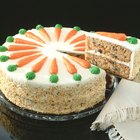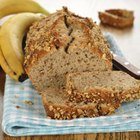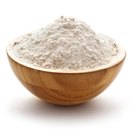
In an ideal world, your kitchen cupboards or pantry would always hold every ingredient you need, every time you want to bake. Reality is usually less obliging, so making emergency substitutions is a regular occurrence for most bakers. Even boxed cake mixes sometimes require a bit of creativity. For example, if you find you're out of oil for the cake, you can substitute melted shortening.
What Fat Does
If you're fat-averse or watching your calories, you might wonder why you even include oil or other fats in a cake mix. The fats in cakes or other baked goods make them rich and soften the crumb by preventing the flour's gluten from forming its usual long, stretchy strands. Instead, fats keep the protein chains short -- hence the term "shortening" -- and the cake remains tender. Scratch-made cakes often start with a solid fat, and won't have the right texture if you use oil. Cake mixes call for oil, so solid fats must be melted first.
Vegetable Shortening vs. Vegetable Oil
Commercial shortening is made by treating vegetable oil so it remains solid instead of liquid at room temperature. If you melt it in your microwave it returns to its original liquid form, and can be used in your cake mixes. It's a quantity-for-quantity substitution, so if your cake calls for 2/3 cup of oil, you would use 2/3 cup of melted shortening. For the most accurate measurement, melt the shortening before measuring it. Any excess can be left at room temperature to solidify, and then may be used for greasing pans. Cool the shortening until it's just warm before adding it to your cake mix, or it could produce a denser texture.
Health Considerations
Manufacturers convert vegetable oil into shortening by treating it with hydrogen, a process called "hydrogenation." It changes the molecular structure of the oil, extending its shelf life and making it resistant to breaking down and becoming rancid. Vegetable shortening retains its neutral flavor better than vegetable oils in long storage. Unfortunately, hydrogenation also creates trans-fats, which have been implicated in heart disease and many other health conditions. Using shortening as an emergency substitution once in a while isn't a grave health risk, but other options are available.
Alternative Substitutions
Most consumers are now aware of the dangers of trans-fats, so many manufacturers have responded by offering shortenings that are non-hydrogenated and free of trans-fats. These can be used the same way as traditional shortenings in your baking. Coconut oil is also solid at room temperature but free of hydrogenation, and can be melted and used if its faint coconut flavor is compatible with your cake. A third option -- if you bake irregularly, and want long shelf life -- is an oil with natural resistance to becoming rancid. High-oleic and mid-oleic sunflower oils both have that characteristic, and mid-oleic sunflower oil is readily available at most supermarkets.
Related Articles

Cake Mix Alternative for Oil

Can You Substitute Shortening for ...

What Are Good Substitutes for Vegetable ...

How to Replace Vegetable Oil for Baking ...

How to Use Shortening Instead of Oil ...

Can You Use Extra Light Olive Oil in a ...

What Is Expeller Pressed Canola Oil?

Canola Oil Vs. Lard in Baking

Does Shortening Go Bad?

Butter Substitute for Baking Scones

What Can Be Used to Substitute for ...

How to Substitute Margarine for Butter ...

Can Jiffy Baking Mix Be Substituted As ...

Substitution for Oil in Baking Brownies

What Kind of Oil Do You Use in Brownie ...

Can You Grease a Pan With Canola Oil?

What Is Vegetable Ghee?

How to Melt Shortening

Can You Use Applesauce in Place of ...

Can You Make a Pumpkin Roll With a Cake ...
References
- On Food and Cooking: The Science and Lore of the Kitchen; Harold McGee
- King Arthur Flour: Fats
Writer Bio
Fred Decker is a trained chef and prolific freelance writer. In previous careers, he sold insurance and mutual funds, and was a longtime retailer. He was educated at Memorial University of Newfoundland and the Northern Alberta Institute of Technology. His articles have appeared on numerous home and garden sites including GoneOutdoors, TheNest and eHow.
Photo Credits
Jupiterimages/Comstock/Getty Images